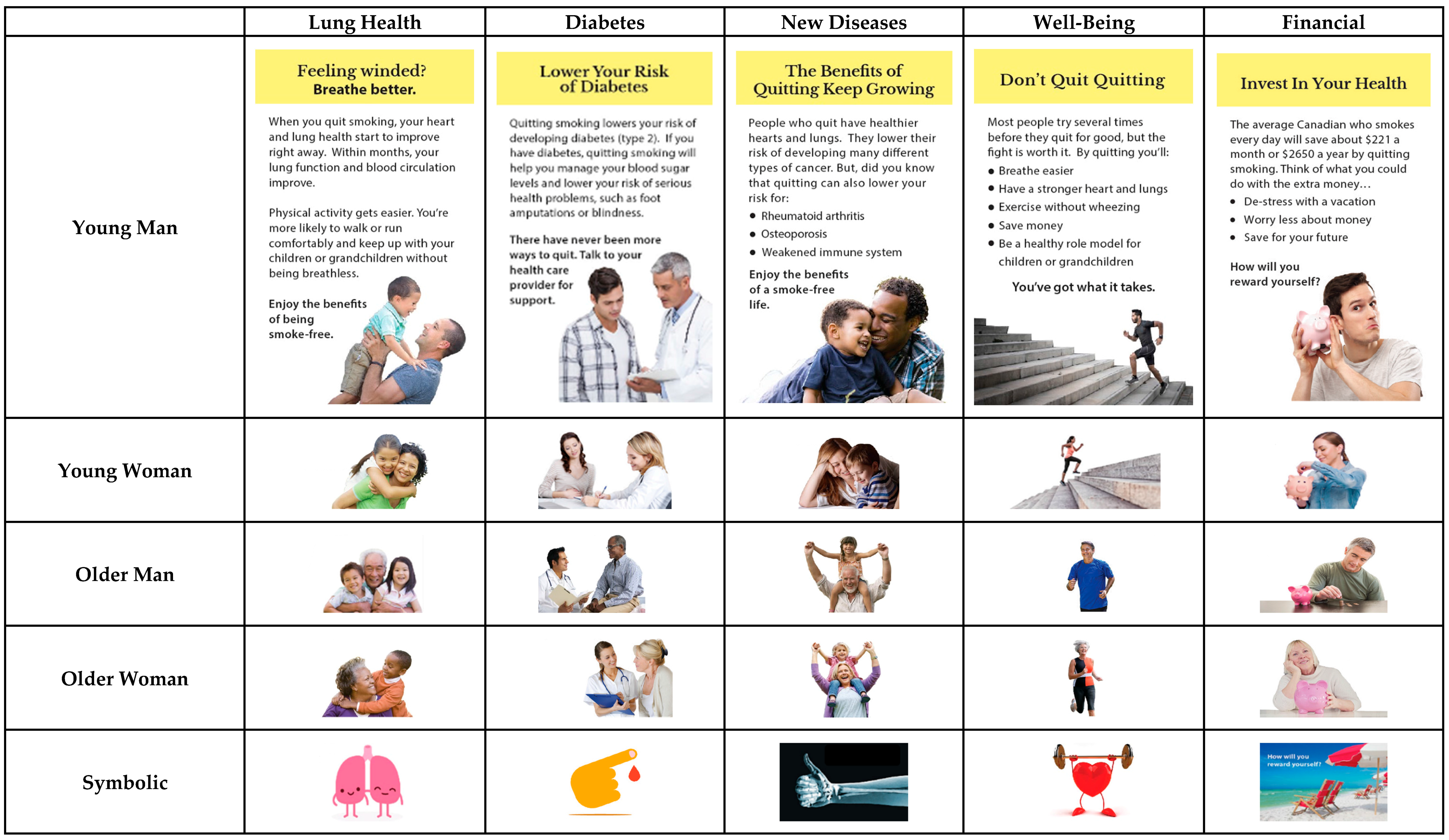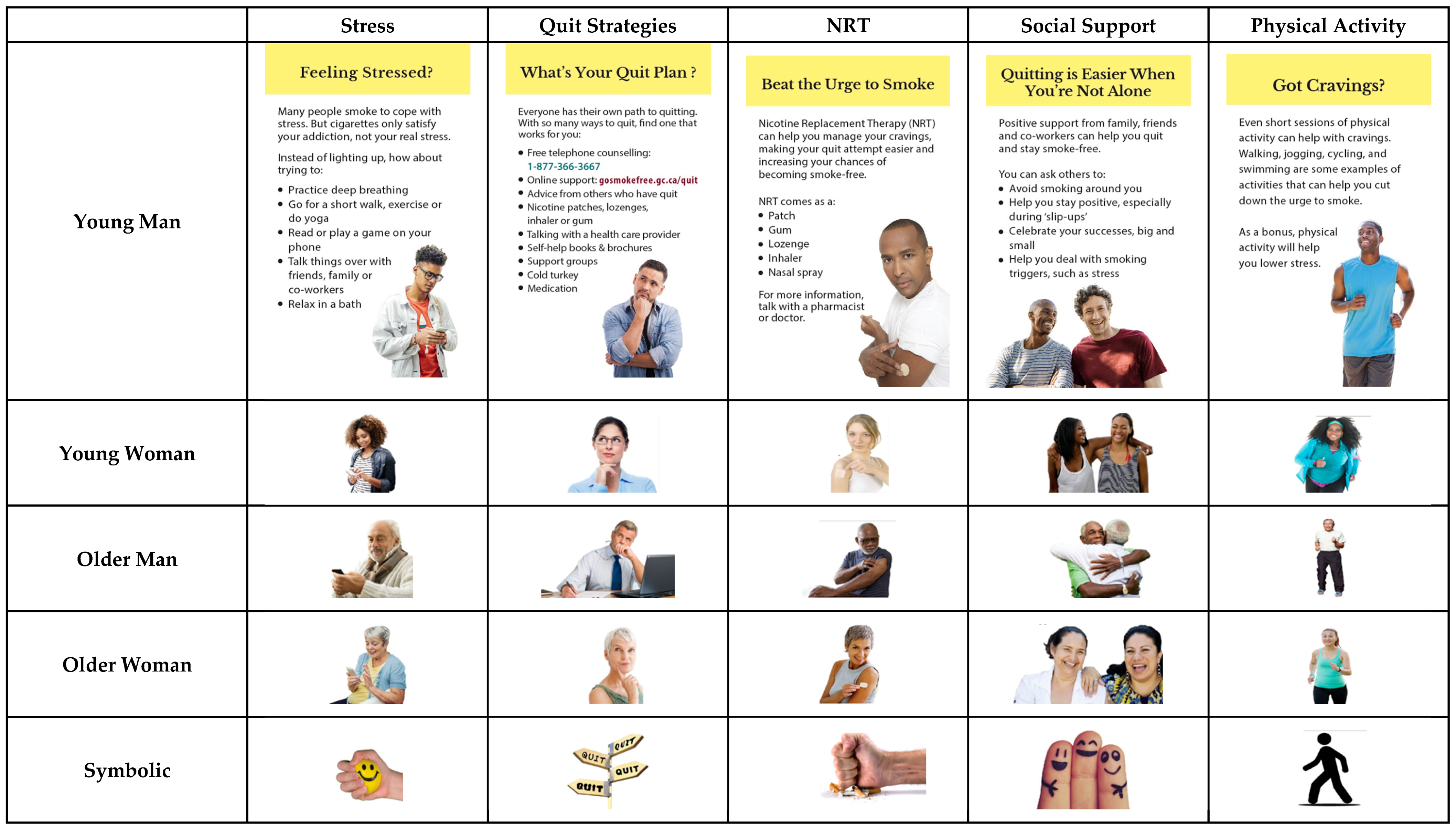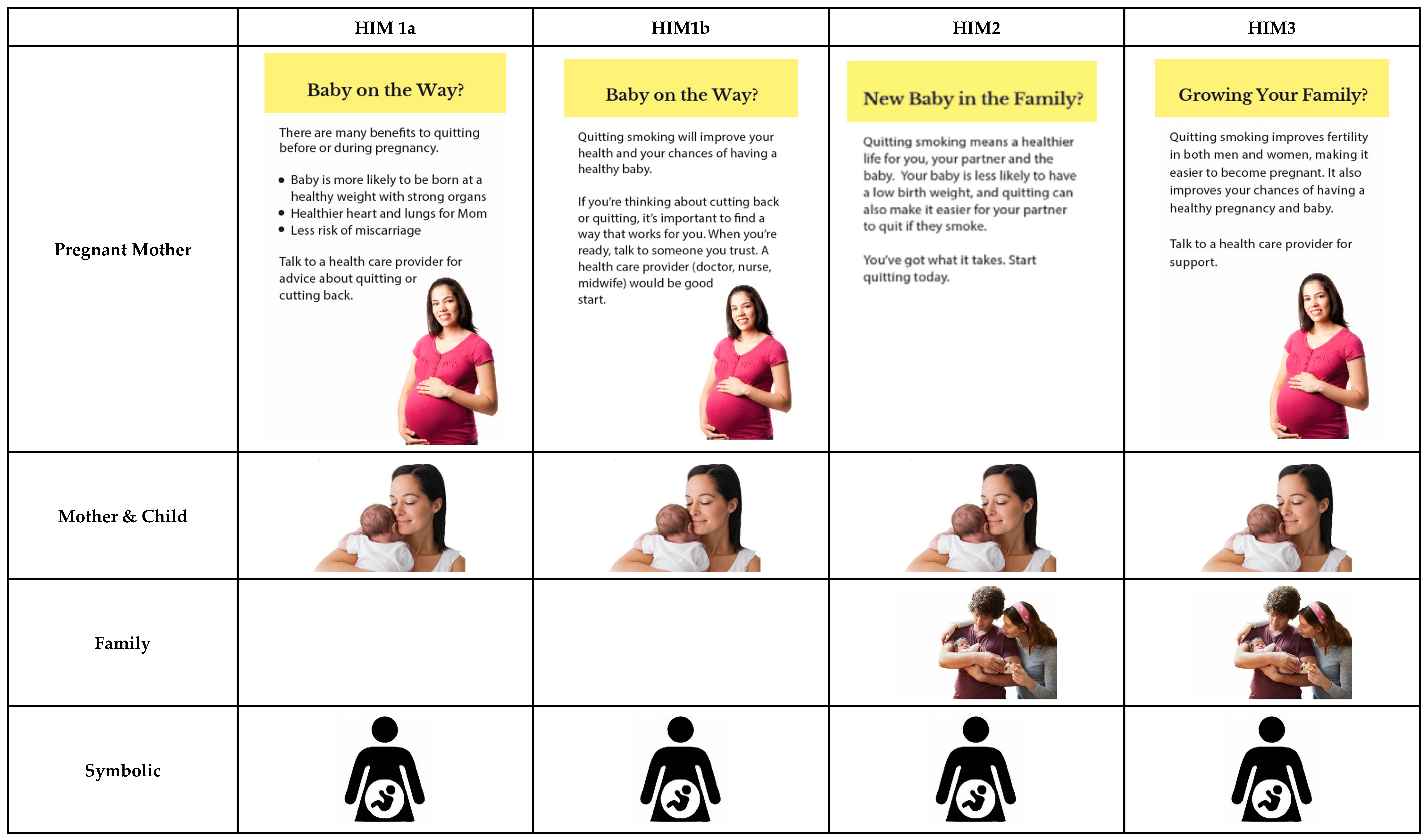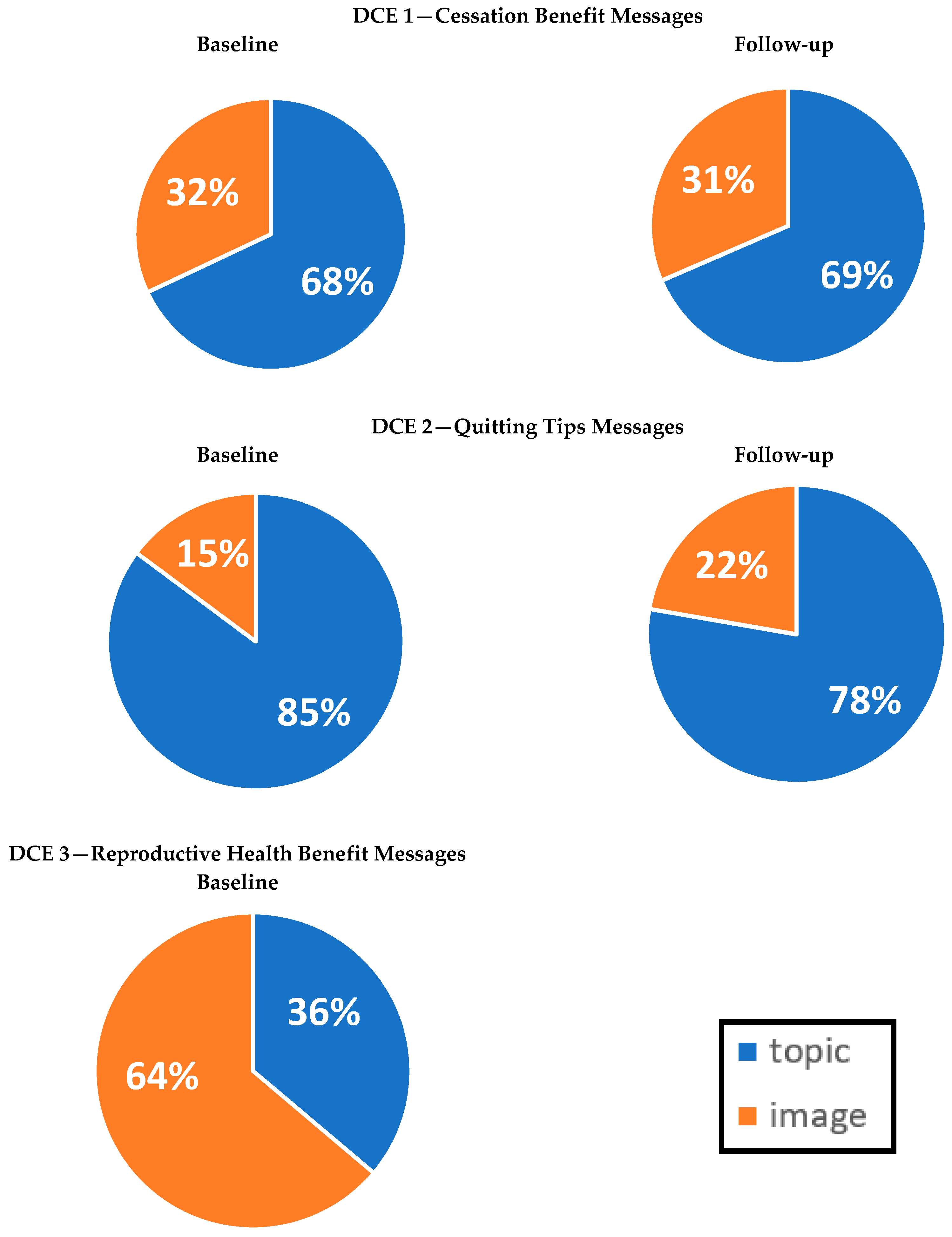Testing Cessation Messages for Cigarette Package Inserts: Findings from a Best/Worst Discrete Choice Experiment
Abstract
:1. Introduction
1.1. Topics for Efficacy Messages about Smoking Cessation
1.2. Pictorial Imagery and Smoking Cessation Messages
1.3. Concordance and Message Effects
1.4. Objective
2. Materials and Methods
2.1. Sample
2.2. Experimental Protocol
2.3. Measures
2.3.1. Dependent Variables
2.3.2. Independent Variables
2.4. Data Analysis
3. Results
3.1. Sample Characteristics
3.2. DCE 1—Cessation Benefit Messages for a General Audience
3.3. Effects of Specific Cessation Benefit Message Topics and Imagery on Choice
3.4. DCE 2—Quitting Tips Messages for a General Audience
3.5. Effects of Specific Quitting Tips Message Topics and Imagery on Choice
3.6. DCE 3—Messages on Reproductive Health Benefits of Cessation
3.7. Effects of Specific Message Topics and Imagery on Choice
3.8. Reliability of DCE
4. Discussion
5. Conclusions
Supplementary Materials
Acknowledgments
Author Contributions
Conflicts of Interest
References
- Canadian Cancer Society. Cigarette Package Health Warnings: International Status Report, 5th ed.; Canadian Cancer Society: Toronto, ON, Canada, 2016. [Google Scholar]
- Noar, S.M.; Francis, D.B.; Bridges, C.; Sontag, J.M.; Ribisl, K.M.; Brewer, N.T. The impact of strengthening cigarette pack warnings: Systematic review of longitudinal observational studies. Soc. Sci. Med. 2016, 164, 118–129. [Google Scholar] [CrossRef] [PubMed]
- Noar, S.M.; Hall, M.G.; Francis, D.B.; Ribisl, K.M.; Pepper, J.K.; Brewer, N.T. Pictorial cigarette pack warnings: A meta-analysis of experimental studies. Tob. Control 2016, 25, 341–354. [Google Scholar] [CrossRef] [PubMed]
- Popova, L. Scaring the snus out of smokers: Testing effects of fear, threat, and efficacy on smokers’ acceptance of novel smokeless tobacco products. Health Commun. 2014, 29, 924–936. [Google Scholar] [CrossRef] [PubMed]
- Witte, K.; Allen, M. A meta-analysis of fear appeals: Implications for effective public health campaigns. Health Educ. Behav. 2000, 27, 591–615. [Google Scholar] [CrossRef] [PubMed]
- Thrasher, J.F.; Osman, A.; Abad-Vivero, E.N.; Hammond, D.; Bansal-Travers, M.; Cummings, K.M.; Hardin, J.V.V.; Moodie, C. The Use of Cigarette Package Inserts to Supplement Pictorial Health Warnings: An Evaluation of the Canadian Policy. Nicotine Tob. Res. 2015, 17, 870–875. [Google Scholar] [CrossRef] [PubMed]
- Thrasher, J.F.; Swayampakala, K.; Cummings, K.M.; Hammond, D.; Anshari, D.; Krugman, D.M.; Hardin, J.W. Cigarette package inserts can promote efficacy beliefs and sustained smoking cessation attempts: A longitudinal assessment of an innovative policy in Canada. Prev. Med. 2016, 88, 59–65. [Google Scholar] [CrossRef] [PubMed]
- Thrasher, J.F.; Carpenter, M.J.; Andrews, J.O.; Gray, K.M.; Alberg, A.J.; Navarro, A.; Friedman, D.B.; Cumminqs, K.M. Cigarette warning label policy alternatives and smoking-related health disparities. Am. J. Prev. Med. 2012, 43, 590–600. [Google Scholar] [CrossRef] [PubMed]
- Hammond, D.; Reid, J.L.; Driezen, P.; Boudreau, C. Pictorial health warnings on cigarette packs in the United States: An experimental evaluation of the proposed FDA warnings. Nicotine Tob. Res. 2013, 15, 93–102. [Google Scholar] [CrossRef] [PubMed]
- Hammond, D.; Thrasher, J.; Reid, J.L.; Driezen, P.; Boudreau, C.; Santillan, E.A. Perceived effectiveness of pictorial health warnings among Mexican youth and adults: A population-level intervention with potential to reduce tobacco-related inequities. Cancer Causes Control 2012, 23 (Suppl. 1), 57–67. [Google Scholar] [CrossRef] [PubMed]
- Thrasher, J.; Arillo-Santillán, E.; Villalobos, V.; Pérez-Hernández, R.; Hammond, D.; Carter, J.; Sebrié, E.; Sansores, R.; Regalado-Pineda, J. Can pictorial warning labels on cigarette packages address smoking-related health disparities? Field experiments in Mexico to assess pictorial warning label content. Cancer Causes Control 2012, 23, 69–80. [Google Scholar] [CrossRef] [PubMed]
- Hammond, D.; Fong, G.T.; MacDonald, P.; Cameron, R.; Brown, K. Impact of graphic Canadian warning labels on adult smoking behavior. Tob. Control 2003, 12, 391–395. [Google Scholar] [CrossRef] [PubMed]
- Thrasher, J.; Anshari, D.; Lambert, V.; Islam, F.; Mead, E.; Popova, L.; Salloum, R.G.; Moodie, C.; Louviere, J.; Lindblom, E.N. Assessing smoking cessation messages with a discrete choice experiment. Tob. Regul. Sci. 2018, 4, 73–87. [Google Scholar]
- Terry-McElrath, Y.; Wakefield, M.; Ruel, E.; Balch, G.I.; Emery, S.; Szczypka, G.; Cleqq-Smith, K.; Flay, B. The effect of antismoking advertisement executional characteristics on youth comprehension, appraisal, recall, and engagement. J. Health Commun. 2005, 10, 127–143. [Google Scholar] [CrossRef] [PubMed]
- Zillmann, D. Exemplification effects in the promotion of safety and health. J. Commun. 2006, 56. [Google Scholar] [CrossRef]
- Petty, R.E.; Cacioppo, J.T. The elaboration likelihood model of persuasion. Adv. Exp. Soc. Psychol. 1986, 19, 123–205. [Google Scholar]
- Brewer, N.; Hall, M.; Noar, S.; Parada, H.; Stein-Seroussi, A.; Bach, L.E.; Hanley, S.; Ribisl, K.M. Effect of pictorial cigarette pack warnings on changes in smoking behavior: A randomized clinical trial. JAMA Intern. Med. 2016, 176, 905–912. [Google Scholar] [CrossRef] [PubMed]
- Evans, A.; Peters, E.; Strasser, A.; Emery, L.; Sheerin, K.; Romer, D. Graphic warning labels elicit affective and thoughtful responses from smokers: Results of a randomized clinical trial. PLoS ONE 2015, 10, e0142879. [Google Scholar] [CrossRef] [PubMed]
- McQueen, A.; Kreuter, M.; Boyum, S.; Thompson, V.; Caburnay, C.; Waters, E.; Kaphinqst, K.A.; Rath, S.; Fu, Q. Reactions to FDA-proposed graphic warning labels affixed to US smokers’ cigarette packs. Nicotine Tob. Res. 2015, 17, 784–795. [Google Scholar] [CrossRef] [PubMed]
- Mutti-Packer, S.; Reid, J.L.; Thrasher, J.F.; Romer, D.; Fong, G.T.; Gupta, P.C.; Pednekar, M.S.; Narqis, N.; Hammond, D. The role of negative affect and message credibility in perceived effectiveness of smokeless tobacco health warning labels in Navi Mumbai, India and Dhaka, Bangladesh: A moderated-mediation analysis. Addict. Behav. 2017, 73, 22–29. [Google Scholar] [CrossRef] [PubMed]
- Cho, Y.; Thrasher, J.; Yong, H.-H.; Szklo, A.; O’Connor, R.; Bansal-Travers, M.; Hammond, D.; Fong, G.T.; Hardin, J.; Borland, R. Path analysis of warning label effects on negative emotions and quit attempts: A longitudinal study of smokers in Australia, Canada, Mexico, and the US. Soc. Sci. Med. 2018, 197, 226–234. [Google Scholar] [CrossRef] [PubMed]
- Thrasher, J.; Villalobos, V.; Szklo, A.; Fong, G.T.; Pérez, C.; Sebrié, E.M.; Sansone, N.; Fiqueiredo, V.; Boado, M.; Arillo-Santillan, E.; et al. Assessing the impact of cigarette package warning labels: A cross-country comparison in Brazil, Uruguay and Mexico. Salud Pública Méx. 2010, 52 (Suppl. 2), S206–S215. [Google Scholar] [CrossRef] [PubMed]
- World Health Organization (WHO). How Large Pictorial Health Warnings on the Packaging of Tobacco Products Affect Knowledge and Behaviour; World Health Organization Regional Office for Europe: Copenhagen, Denmark, 2014. [Google Scholar]
- Kreuter, M.W.; Strecher, V.J.; Glassman, B. One size does not fit all: The case for tailoring print materials. Ann. Behav. Med. 1999, 21, 276–283. [Google Scholar] [CrossRef] [PubMed]
- McGuire, W.J. Theoretical foundations of campaigns. In Public Communication Campaigns, 2nd ed.; Rice, R.E., Atkin, C.K., Eds.; Sage: Newbury Park, CA, USA, 1991. [Google Scholar]
- Hawkins, R.P.; Kreuter, M.; Resnicow, K.; Fishbein, M.; Dijkstra, A. Understanding tailoring in communicating about health. Health Educ. Res. 2008, 23, 454–466. [Google Scholar] [CrossRef] [PubMed]
- Skinner, C.S.; Campbell, M.K.; Rimer, B.K.; Curry, S.; Prochaska, J.O. How effective is tailored print communication? Ann. Behav. Med. 1999, 21, 290–298. [Google Scholar] [CrossRef] [PubMed]
- Kollath-Cattano, C.; Osman, A.; Thrasher, J.F. Evaluating the perceived effectiveness of pregnancy-related cigarette package health warning labels among different gender/age groups. Addict. Behav. 2017, 66, 33–40. [Google Scholar] [CrossRef] [PubMed]
- Osman, A.; Thrasher, J.; Yong, H.-H.; Arillo-Santillán, E.; Hammond, D. Disparagement of health warning labels on cigarette packages and smoking cessation: Results from four countries. Health Educ. Res. 2017, 32, 524–536. [Google Scholar] [CrossRef] [PubMed]
- Thrasher, J.; Osman, A.; Moodie, C.; Hammond, D.; Bansal-Travers, M.; Cummings, K.; Borland, R.; Yong, H.H.; Hardin, J. Promoting cessation resources through cigarette package warning labels: A longitudinal survey with adult smokers in Australia, Canada and Mexico. Tob. Control 2015, 24, e23–e31. [Google Scholar] [CrossRef] [PubMed]
- Willemsen, M.C. The new EU cigarette health warnings benefit smokers who want to quit the habit: Results from the Dutch continuous survey of smoking habits. Eur. J. Public Health 2005, 15, 389–392. [Google Scholar] [CrossRef] [PubMed]
- Villanti, A.; Cantrell, J.; Pearson, J.; Vallone, D.; Rath, J. Perceptions and perceived impact of graphic cigarette health warning labels on smoking behavior among U.S. young adults. Nicotine Tob. Res. 2014, 16, 469–477. [Google Scholar] [CrossRef] [PubMed]
- Clark, M.D.; Determann, D.; Petrou, S.; Moro, D.; de Bekker-Grob, E.W. Discrete choice experiments in health economics: A review of the literature. Pharmacoeconomics 2014, 32, 883–902. [Google Scholar] [CrossRef] [PubMed]
- De Bekker-Grob, E.W.; Ryan, M.; Gerard, K. Discrete choice experiments in health economics: A review of the literature. Health Econ. 2012, 21, 145–172. [Google Scholar] [CrossRef] [PubMed]
- Lancsar, E.; Louviere, J. Conducting discrete choice experiments to inform healthcare decision making: A user’s guide. Pharmacoeconomics 2008, 26, 661–677. [Google Scholar] [CrossRef] [PubMed] [Green Version]
- Louviere, J.; Hensher, D.; Swait, J. Stated Choice Methods: Analysis and Applications; Cambridge University Press: Cambridge, UK, 2000. [Google Scholar]
- Phillip Morris. Coupon Optimization at Individual Level Conjoint Analysis; Phillip Morris: New York, NY, USA, 1998. [Google Scholar]
- Dennis & Company Research. Cigarette Visual Comparison Study: Concept Evaluation; R.J. Reynolds: Winston-Salem, NC, USA, 1999. [Google Scholar]
- Hirji, T. Project Sky Conjoint; British American Tobacco: London, UK, 1996. [Google Scholar]
- Devinney, T. Analysis of Consumer Research Evidence on the Impact of Plain Packaging for Tobacco Products (Updated to 2014); Japan Tobacco International: Tokyo, Japan, 2014. [Google Scholar]
- Hoek, J.; Gendall, P.; Eckert, C.; Louviere, J. Dissuasive cigarette sticks: The next step in standardised (‘plain’) packaging? Tob. Control 2016, 25, 699–705. [Google Scholar] [CrossRef] [PubMed]
- Kotnowski, K.; Fong, G.T.; Gallopel-Morvan, K.; Islam, T.; Hammond, D. The impact of cigarette packaging design among young females in Canada: Findings from a discrete choice experiment. Nicotine Tob. Res. 2016, 18, 1348–1356. [Google Scholar] [CrossRef] [PubMed]
- Hoek, J.; Gendall, P.; Eckert, C.; Kemper, J.; Louviere, J. Effects of brand variants on smokers’ choice behaviours and risk perceptions. Tob. Control 2016, 25, 160–165. [Google Scholar] [CrossRef] [PubMed]
- Salloum, R.G.; Louviere, J.J.; Getz, K.R.; Islam, F.; Anshari, D.; Cho, Y.; O’Connor, R.J.; Hammond, D.; Thrasher, J.F. Evaluation of strategies to communicate harmful and potentially harmful constituent (HPHC) information through cigarette package inserts: A discrete choice experiment. Tob. Control 2017. [Google Scholar] [CrossRef] [PubMed]
- Louviere, J.J.; Flynn, T.N.; Marley, A.A. Best-Worst Scaling: Theory, Methods and Applications; Cambridge University Press: Cambridge, UK, 2015. [Google Scholar]
- Jackson, S.A. Message Effects Research: Principles of Design and Analysis; Guilford Press: New York, NY, USA, 1992. [Google Scholar]
- Heatherton, T.F.; Kozlowski, L.T.; Frecker, R.C.; Rickert, W.; Robinson, J. Measuring the Heaviness of Smoking: Using self-reported time to the first cigarette of the day and number of cigarettes smoked per day. Addiction 1989, 84, 791–800. [Google Scholar] [CrossRef]
- International Agency for Research on Cancer (IARC). IARC Handbooks of Cancer Prevention: Tobacco Control; Methods for Evaluating Tobacco Control Policies; IARC: Lyon, France, 2009; Volume 12. [Google Scholar]
- Godin, G.; Kok, G. The theory of planned behavior: A review of its applications to health-related behaviors. Am. J. Health Promot. 1996, 11, 87–98. [Google Scholar] [CrossRef] [PubMed]
- Armitage, C.J.; Conner, M. Efficacy of the Theory of Planned Behavior: A meta-analytic review. Br. J. Soc. Psychol. 2001, 40, 471–499. [Google Scholar] [CrossRef] [PubMed]
- West, R.; Sohal, T. “Catastrophic” pathways to smoking cessation: Findings from national survey. Br. Med. J. 2006, 332, 458–460. [Google Scholar] [CrossRef] [PubMed]
- Viswanath, K. Public communications and its role in reducing and eliminating health disparities. In Examining the Health Disparities Research Plan of the National Institutes of Health: Unfinished Business; Thomson, G., Mitchell, F., Williams, M., Eds.; Institute of Medicine: Washington, DC, USA, 2006; pp. 215–253. [Google Scholar]
- Cantrell, J.; Vallone, D.M.; Thrasher, J.; Nagler, R.H.; Feirman, S.P.; Muenz, L.R.; He, D.Y.; Viswanath, K. Impact of tobacco-related health warning labels across socioeconomic, race and ethnic groups: Resutls from a randomized web-based experiment. PLoS ONE 2013, 8, e52206. [Google Scholar] [CrossRef] [PubMed] [Green Version]
- Thrasher, J.; Rousu, M.C.; Hammond, D.; Navarro, A.M.; Corrigan, J.R. Estimating the impact of pictorial health warnings and “plain” cigarette packaging: Evidence from experimental auctions among adult smokers in the United States. Health Policy 2011, 102, 41–48. [Google Scholar] [CrossRef] [PubMed]
- Gibson, L.; Brennan, E.; Momjian, A.; Shapiro-Luft, D.; Seitz, H.; Cappella, J.N. Assessing the consequences of implementing graphic warning labels on cigarette packs for tobacco-related health disparities. Nicotine Tob. Res. 2015, 17, 898–907. [Google Scholar] [CrossRef] [PubMed]
- Durkin, S.J.; Biener, L.; Wakefield, M.A. Effects of different types of antismoking ads on reducing disparities in smoking cessation among socioeconomic subgroups. Am. J. Public Health 2009, 99, 2217–2223. [Google Scholar] [CrossRef] [PubMed]
- Niederdeppe, J.; Farrelly, M.C.; Nonnemaker, J.; Davis, K.C.; Wagner, L. Socioeconomic variation in recall and perceived effectiveness of campaign advertisements to promote smoking cessation. Soc. Sci. Med. 2011, 72, 773–780. [Google Scholar] [CrossRef] [PubMed]
- Niederdeppe, J.; Fiore, M.C.; Baker, T.B.; Smith, S.S. Smoking-cessation media campaigns and their effectiveness among socioeconomically advantaged and disadvantaged populations. Am. J. Public Health 2008, 98, 916–924. [Google Scholar] [CrossRef] [PubMed]
- Lochbuehler, K.; Mercincavage, M.; Tang, K.; Tomlin, D.; Cappella, J.; Strasser, A. Effect of message congruency on attention and recall in pictorial health warning labels. Tob. Control 2017. [Google Scholar] [CrossRef] [PubMed]
- Feinstein, A.; Cicchetti, D. High agreement but low kappa: I. The problems of two paradoxes. J. Clin. Epidemiol. 1990, 43, 543–549. [Google Scholar] [CrossRef]
- Huang, L.; Thrasher, J.; Reid, J.; Hammond, D. Predictive and external validity of a pre-market study to determine the most effective pictorial health warning label content for cigarette packages. Nicotine Tob. Res. 2016, 18, 1376–1381. [Google Scholar] [CrossRef] [PubMed]
- Osman, A.; Thrasher, J.; Cayir, E.; Hardin, J.; Perez-Hernandez, R.; Froeliger, B. Depressive symptoms and responses to cigarette pack warning labels among Mexican smokers. Health Psychol. 2016, 35, 442–453. [Google Scholar] [CrossRef] [PubMed]





| Characteristics | Baseline Sample | Follow-Up Sample |
|---|---|---|
| (n = 1000) | (n = 582) | |
| Age | ||
| 18–29 | 16% | 11% |
| 30–39 | 25% | 22% |
| 40–49 | 18% | 19% |
| 50–64 | 41% | 48% |
| Sex | ||
| Male | 42% | 46% |
| Female | 58% | 54% |
| Education | ||
| High school or less | 33% | 32% |
| College or some university | 37% | 37% |
| Completed university or higher | 31% | 32% |
| Income | ||
| Under $30,000 | 23% | 21% |
| $30,000–59,999 | 28% | 28% |
| $60,000–99,999 | 28% | 30% |
| $100,000 and over | 17% | 18% |
| Smoking frequency | ||
| Every day | 78% | 79% |
| Some days | 23% | 21% |
| HSI (mean ± standard deviation) | 3.08 ± 1.36 | 3.09 ± 1.28 |
| Quit Intention in next 6 months | ||
| Yes | 50% | 43% |
| Quit attempt in the past 4 months | ||
| Yes | 45% | 40% |
| DCE 1—cessation benefits | ||
| Analytic sample * | 80% | 78%/72% |
| DCE 2—quitting tips | ||
| Analytic sample ** | 78% | 77%/73% |
| DCE 3—reproductive health benefits | ||
| Analytic sample * | 58% | 53%/NA |
| Characteristics | Baseline DCE 1 | Follow-Up DCE 1 | |
|---|---|---|---|
| b (SE) | b (SE) | ||
| Model 1: Main effects of message characteristics | |||
| Message Topic | |||
| improving lung health | 0.000 (0.004) | −0.008 (0.006) | |
| avoiding diabetes | 0.014 ** (0.004) | 0.015 * (0.006) | |
| new disease | 0.015 *** (0.004) | 0.007 (0.006) | |
| enhancing wellbeing | −0.013 ** (0.004) | 0.011 (0.006) | |
| financial benefits | −0.016 *** (0.004) | −0.025 *** (0.006) | |
| Overall p-value | <0.001 | <0.001 | |
| Imagery Type | |||
| young man | −0.007 (0.004) | 0.001 (0.006) | |
| young woman | 0.008 (0.004) | 0.009 (0.006) | |
| older man | −0.005 (0.004) | −0.009 (0.006) | |
| older woman | −0.001 (0.004) | 0.001 (0.006) | |
| symbolic | 0.005 (0.004) | −0.003 (0.006) | |
| Overall p-value | 0.150 | 0.436 | |
| Model 2: Participant sex X Image type | |||
| Male participant | young man | −0.007 (0.007) | 0.011 (0.010) |
| young woman | 0.013 (0.007) | −0.004 (0.009) | |
| older man | −0.006 (0.007) | 0.000 (0.009) | |
| older woman | −0.015 * (0.007) | −0.003 (0.010) | |
| symbolic | 0.016 * (0.007) | 0.004 (0.009) | |
| Female participant | young man | −0.007 (0.006) | −0.007 (0.009) |
| young woman | 0.003 (0.006) | 0.020 * (0.009) | |
| older man | −0.005 (0.006) | −0.016 (0.009) | |
| older woman | 0.009 (0.006) | 0.004 (0.009) | |
| symbolic | −0.002 (0.006) | −0.008 (0.009) | |
| Overall p-value | 0.052 | 0.242 | |
| Model 3: Participant age X Image type | |||
| 18–39 years old participant | young man | −0.003 (0.007) | 0.008 (0.011) |
| young woman | 0.001 (0.007) | 0.014 (0.010) | |
| older man | 0.005 (0.007) | −0.013 (0.011) | |
| older woman | −0.002 (0.007) | 0.004 (0.011) | |
| symbolic | 0.005 (0.007) | 0.000 (0.011) | |
| 40–64 years old participant | young man | −0.010 (0.006) | −0.003 (0.008) |
| young woman | 0.013 * (0.006) | 0.005 (0.008) | |
| older man | −0.014 * (0.006) | −0.008 (0.008) | |
| older woman | −0.001 (0.006) | −0.001 (0.008) | |
| symbolic | 0.006 (0.006) | −0.006 (0.008) | |
| Overall p-value | 0.190 | 0.820 | |
| Characteristics | Baseline DCE 2 | Follow-Up DCE 2 | |
|---|---|---|---|
| b (SE) | b (SE) | ||
| Model 1: Main effects of message characteristics | |||
| Message Topic | |||
| stress reduction | 0.013 ** (0.004) | 0.002 (0.006) | |
| list of cessation strategies | −0.046 *** (0.004) | −0.032 *** (0.006) | |
| nicotine replacement therapy | 0.011 * (0.004) | 0.010 (0.006) | |
| social support | 0.017 *** (0.005) | 0.015 * (0.006) | |
| physical activity | 0.005 (0.004) | 0.005 (0.006) | |
| Overall p-value | <0.001 | <0.001 | |
| Imagery Type | |||
| young man | −0.006 (0.004) | 0.002 (0.006) | |
| young woman | 0.003 (0.004) | −0.005 (0.006) | |
| older man | 0.003 (0.004) | 0.004 (0.006) | |
| older woman | −0.005 (0.004) | 0.006 (0.006) | |
| symbolic | 0.005 (0.004) | −0.007 (0.006) | |
| Overall p-value | 0.375 | 0.546 | |
| Model 2: Participant sex X Image type | |||
| Male participant | young man | −0.001 (0.007) | 0.009 (0.009) |
| young woman | 0.006 (0.007) | −0.010 (0.010) | |
| older man | 0.006 (0.007) | 0.019 * (0.010) | |
| older woman | −0.013 (0.007) | −0.020 * (0.010) | |
| symbolic | 0.005 (0.007) | −0.003 (0.009) | |
| Female participant | young man | −0.010 (0.006) | −0.003 (0.009) |
| young woman | 0.000 (0.006) | −0.001 (0.009) | |
| older man | 0.001 (0.006) | −0.009 (0.009) | |
| older woman | 0.001 (0.006) | 0.029 ** (0.009) | |
| symbolic | 0.004 (0.006) | −0.011 (0.009) | |
| Overall p-value | 0.584 | 0.010 | |
| Model 3: Participant age X Image type | |||
| 18–39 years old participant | young man | 0.003 (0.007) | 0.012 (0.011) |
| young woman | −0.002 (0.007) | −0.012 (0.011) | |
| older man | 0.000 (0.007) | −0.010 (0.011) | |
| older woman | −0.001 (0.007) | 0.010 (0.011) | |
| symbolic | 0.005 (0.007) | 0.001 (0.011) | |
| 40–64 years old participant | young man | −0.014 * (0.006) | −0.003 (0.008) |
| young woman | 0.006 (0.006) | −0.002 (0.008) | |
| older man | 0.006 (0.006) | 0.012 (0.008) | |
| older woman | −0.008 (0.006) | 0.003 (0.008) | |
| symbolic | 0.004 (0.006) | −0.012 (0.008) | |
| Overall p-value | 0.447 | 0.507 | |
| Characteristics | Baseline DCE 3 | |
|---|---|---|
| b (SE) | ||
| Model 1: Main effects of message characteristics | ||
| Message Topic | ||
| health of mom & baby | 0.093 *** (0.012) | |
| health of mom & baby + quit tips | −0.006 (0.013) | |
| health of mom, dad & baby | 0.031 * (0.013) | |
| fertility of mom & dad, healthy pregnancy & baby | −0.118 *** (0.011) | |
| Overall p-value | <0.001 | |
| Imagery Type | ||
| pregnant mom | 0.023 (0.013) | |
| mom with baby | 0.107 *** (0.011) | |
| mom & dad with baby | 0.122 *** (0.015) | |
| symbolic (pregnant mom) | −0.252 *** (0.011) | |
| Overall p-value | <0.001 | |
| Model 2: Participant sex X Image type | ||
| Male participant | pregnant mom | −0.012 (0.020) |
| mom with baby | 0.092 *** (0.017) | |
| mom & dad with baby | 0.223 *** (0.024) | |
| symbolic (pregnant mom) | −0.266 *** (0.017) | |
| Female participant | pregnant mom | 0.045 * (0.018) |
| mom with baby | 0.116 *** (0.015) | |
| mom & dad with baby | 0.045 * (0.021) | |
| symbolic (pregnant mom) | −0.244 *** (0.019) | |
| Overall p-value | <0.001 | |
| Model 3: Participant age X Image type | ||
| 18–39 years old participant | pregnant mom | 0.032 (0.019) |
| mom with baby | 0.094 *** (0.016) | |
| mom & dad with baby | 0.111 *** (0.022) | |
| symbolic (pregnant mom) | −0.240 *** (0.016) | |
| 40–64 years old participant | pregnant mom | 0.013 (0.019) |
| mom with baby | 0.120 *** (0.016) | |
| mom & dad with baby | 0.134 *** (0.023) | |
| symbolic (pregnant mom) | −0.264 *** (0.019) | |
| Overall p-value | <0.001 | |
© 2018 by the authors. Licensee MDPI, Basel, Switzerland. This article is an open access article distributed under the terms and conditions of the Creative Commons Attribution (CC BY) license (http://creativecommons.org/licenses/by/4.0/).
Share and Cite
Thrasher, J.F.; Islam, F.; Davis, R.E.; Popova, L.; Lambert, V.; Cho, Y.J.; Salloum, R.G.; Louviere, J.; Hammond, D. Testing Cessation Messages for Cigarette Package Inserts: Findings from a Best/Worst Discrete Choice Experiment. Int. J. Environ. Res. Public Health 2018, 15, 282. https://doi.org/10.3390/ijerph15020282
Thrasher JF, Islam F, Davis RE, Popova L, Lambert V, Cho YJ, Salloum RG, Louviere J, Hammond D. Testing Cessation Messages for Cigarette Package Inserts: Findings from a Best/Worst Discrete Choice Experiment. International Journal of Environmental Research and Public Health. 2018; 15(2):282. https://doi.org/10.3390/ijerph15020282
Chicago/Turabian StyleThrasher, James F., Farahnaz Islam, Rachel E. Davis, Lucy Popova, Victoria Lambert, Yoo Jin Cho, Ramzi G. Salloum, Jordan Louviere, and David Hammond. 2018. "Testing Cessation Messages for Cigarette Package Inserts: Findings from a Best/Worst Discrete Choice Experiment" International Journal of Environmental Research and Public Health 15, no. 2: 282. https://doi.org/10.3390/ijerph15020282





